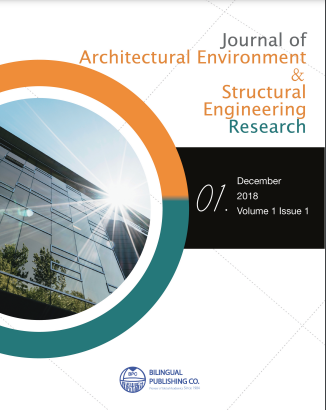-
371
-
208
-
183
-
179
-
168
Early stage Design Workflow for high Energy Performance Multi-storey Residential Buildings
DOI:
https://doi.org/10.30564/jaeser.v1i1.218Abstract
This paper presents a methodology to optimize building envelope energy performance for multi-storey residential buildings using a design performance model approach. Five analysis techniques, applied to a database of parametric simulation results, are proposed to derive information on various building performance features that can support early design decisions. Information may include optimal combination of design parameter values to achieve lowest energy consumption, or the relative impact of design parameters on a given design, such as a base case. A workflow template is established to provide support for the design process of energy efficient multi-storey residential buildings. This template can form a basis for the development of an interactive tool that integrates energy performance principles into early stage design decisions. The application of this methodology to a building in Vancouver (BC, Canada, 49°N) is presented as a case study. Results of this application demonstrates that adopting a specific combination of building envelope parameters, thermal load can be reduced by up to 85% as compared to a base case designed according to commonly built apartment buildings in the studied location.
Keywords:
Multi-storey buildings; Residential; Energy performance; Design performance models; Modelling analysis techniquesReferences
[1] Hachem, Caroline, Andreas Athienitis, and Paul Fazio. 2014. “Energy Performance Enhancement in Multistory Residential Buildings.” Applied Energy,2014,116,9–19. DOI: https://doi.org/10.1016/j.apenergy.2013.11.018
[2] Sozer, H., 2010. Improving energy efficiency through the design of the building envelope. Building and environment, 2010, 45(12), 2581-2593.
[3] Li, D.H., Yang, L. and Lam, J.C., 2013. Zero energy buildings and sustainable development implications–A review. Energy, 2013, 54, 1-10.
[4] West, S., 2001. Improving the sustainable development of building stock by the implementation of energy efficient, climate control technologies. Building and Environment, 2001, 36(3), 281-289.
[5] Khan, M.A., Mishra, S. & Haque, A. A Present and Future State of Art Development for Energy Efficient Buildings using PV Systems. Intelligent Building International (Taylor and Francis),2018.
[6] Hachem, Caroline, and Mohanmed Elsayed. “Patterns of Facade System Design for Enhanced Energy Performance of Multistory Buildings.” Energy and Buildings, Elsevier B.V.2016, : 366–77. DOI: https://doi.org/10.1016/j.enbuild.2016.08.051
[7] Khan, M.A., Mishra, S. & Harish, V.S.K.V. Grid Connected Energy Efficient Building with Roof Top SPV. IEEE second International Conference on Recent Developments in Control, Automation and Power Engineering (RDCAPE), Amity University, Noida, https://ieeexplore.ieee.org/document/8358252/
[8] (AIA) The American Institute of Architects. 2012. “An Architect’s Guide to Integrating Energy Modelling in the Design Process.”
[9] Ochoa, Carlos Ernesto, and Isaac Guedi Capeluto. 2009. “Advice Tool for Early Design Stages of Intelligent Facades Based on Energy and Visual Comfort Approach.” Energy and Buildings ,2009, 41 (5), 480–88. DOI: https://doi.org/10.1016/j.enbuild.2008.11.015
[10] Attia, Shady, Elisabeth Gratia, André De Herde, and Jan L.M. Hensen. 2012. “Simulation-Based Decision Support Tool for Early Stages of Zero-Energy Building Design.” Energy and Buildings ,2012, 49, 2–15. DOI: https://doi.org/10.1016/j.enbuild.2012.01.028
[11] Hemsath, Timothy L. “Conceptual Energy Modelling for Architecture, Planning and Design: Impact of Using Building Performance Simulation in Early Design Stages.” Proceedings of BS 2013: 13th Conference of the International Building Performance Simulation Association, 2013, 376–84. http://www.scopus.com/inward/record.url?eid=2-s2.0-84886645991&partnerID=tZOtx3y1
[12] Yıldız, Y. and Arsan, Z.D.. Identification of the building parameters that influence heating and cooling energy loads for apartment buildings in hot-humid climates. Energy, 2011, 36(7), 4287-4296.
[13] Samuelson, Holly, Sebastian Claussnitzer, Apoorv Goyal, Yujiao Chen, and Alejandra Romo-Castillo. “Parametric Energy Simulation in Early Design: High-Rise Residential Buildings in Urban Contexts.” Building and Environment, DOI: https://doi.org/10.1016/j.buildenv.2016.02.018
[14] Hygh, Janelle S., Joseph F. DeCarolis, David B. Hill, and S. Ranji Ranjithan. “Multivariate Regression as an Energy Assessment Tool in Early Building Design.” Building and Environment. DOI: https://doi.org/10.1016/j.buildenv.2012.04.021
[15] Tian, Wei. “A Review of Sensitivity Analysis Methods in Building Energy Analysis.” Renewable and Sustainable Energy Reviews . DOI: https://doi.org/10.1016/j.rser.2012.12.014
[16] Harish, V. S. K. V., and Arun Kumar. “Reduced Order Modeling and Parameter Identification of a Building Energy System Model Through an Optimization Routine.” Applied Energy , 2016a,162: 1010–1023.
[17] Harish, V. S. K. V., and Arun Kumar. “A Review on Modeling and Simulation of Building Energy Systems.”Renewable and Sustainable Energy Reviews, 2016b, 56, 1272–1292. DOI: https://doi.org/10.1016/j.rser.2015.12.040
[18] U.S. Department of Energy. 2016. “EnergyPlus.” https://energyplus.net/downloads
[19] Zhang, Yi. 2012. “Use jEPlus as an Efficient Building Design Optimisation Tool.” CIBSE ASHRAE Technical Symposium.
[20] Hachem C., A. Athienitis, Effect of Residential Building Design on Energy Performance, ASHRAE journal, 2013, 55(1), 72-74.
[21] Crawley, Drury B., Linda K. Lawrie, Frederick C. Winkelmann, W. F. Buhl, Y. Joe Huang, Curtis O. Pedersen, Richard K. Strand, et al. 2001. “EnergyPlus: Creating a New-Generation Building Energy Simulation Program.” Energy and Buildings,2001, 33 (4), 319–31. DOI: https://doi.org/10.1016/S0378-7788(00)00114-6
[22] (RDH) RDH Building Engineering Ltd. “Energy Consumption and Conservation in Mid- and High-Rise Residential Buildings in British Columbia.” DOI: https://doi.org/10.1017/CBO9781107415324.004
[23] Heiselberg, P., Brohus, H., Hesselholt, A., Rasmussen, H., Seinre, E. and Thomas, S., Application of sensitivity analysis in design of sustainable buildings. Renewable Energy,2009, 34(9), 2030-2036.
[24] Schroeder, Larry D. 1986. Understanding Regression Analysis An Introductory Guide. Beverly Hills: Sage Publications.
[25] (CMHC) Canada Mortgage and Housing Corporation. 2013. “CANADIAN HOUSING OBSERVER.” http://www.cmhc-schl.gc.ca/odpub/pdf/67989.pdf
[26] (NRCAN) National Research Council Canada. National Energy Code of Canada for Buildings . 2011.
[27] Carmody, John, and Kerry Haglund. “Measure Guideline : Energy-Efficient Window Performance and Selection,”2012.
[28] Sartori, Igor, Sonja Geier, Roberto Lollini, Andreas Athienitis, and Lorenzo Pagliano. “Comfort and Energy Efficiency Recommendations for Net Zero Energy Buildings.” Energy, DOI: https://doi.org/10.1111/j.1945-1474.2011.00166.x
[29] Landis, R.S., Standardized regression coefficients. Wiley StatsRef: Statistics Reference Online. 2005.
[30] Hachem C., A. Athienitis, P. Fazio, Parametric investigation of geometric form effects on solar potential of housing units, Journal of Solar Energy, 2011, 85(9), 1864-1877.
Downloads
How to Cite
Issue
Article Type
License
Copyright © 2018 C. Hachem, R. Beckett

This is an open access article under the Creative Commons Attribution-NonCommercial 4.0 International (CC BY-NC 4.0) License.




 C. Hachem
C. Hachem





